National Science and Engineering Week
Every year the Cambridge Science Festival celebrates some of the best and most exciting science and engineering going on in the UK - and the Naked Scientists were there! Find out about the cool science of ice cream, the microscopic world of microbes, and the IgNobel awards for science at its most silly. Looking further afield, the University of Auckland's Peter Metcalf unlocks the secrets of a viral sarcophagus, and Mike Brown from the California Institute of Technology discusses the origin of some mysterious objects in the Kuiper Belt. To cool us down after all that excitement, Dave and Azi sit back and explain the best way to get a cold beer.
In this episode

- What causes the Earth to have a magnetic field?
What causes the Earth to have a magnetic field?
Dave - They're not sure but they think its to do with the centre of the Earth being a liquid metal ball and you get convection currents in that. There's a strange thing where it excites itself and turns itself into a dynamo, you get electric currents which make an electro magnet and that's what they reckon is making the magnetic field. Chris - The field does flip from time to time doesn't it? I think the average is about every 100, 000 years, but in fact its less than that.
Dave - Yes, they reckon we're due for one fairly soon as the Earth's magnetic field is getting weaker very fast.
Chris - So does the North pole become the South Pole? Dave - Yes.

Moody Teenagers
That is SO unfair - Researchers have stumbled on the cause of teenage angst. Sheryl Smith, from SUNY Downstate Medical Centre in New York, has found that a hormone called THP or allopregnanolone, which normally provokes mental calm in adults has the opposite effect in the teenage brain. At around the time of puberty there are significant increases in the levels of a cellular receptor (docking station) for the nerve chemical GABA.  This is especially marked in a part of the brain known as the limbic system, which controls emotion. THP usually increases the activity of this GABA signalling system, which in turn helps to reduce anxiety and act as a natural stress buster. But during puberty it has the opposite effect and instead makes the brain's emotional centre more excitable, triggering anxiety and mood swings. Thankfully, parents can breathe a collective sigh of relief, because the effect is only temporary (except amongst men in whom it seems to get progressively worse with age)!
This is especially marked in a part of the brain known as the limbic system, which controls emotion. THP usually increases the activity of this GABA signalling system, which in turn helps to reduce anxiety and act as a natural stress buster. But during puberty it has the opposite effect and instead makes the brain's emotional centre more excitable, triggering anxiety and mood swings. Thankfully, parents can breathe a collective sigh of relief, because the effect is only temporary (except amongst men in whom it seems to get progressively worse with age)!
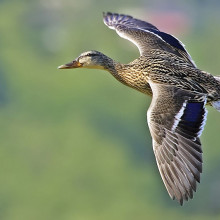
Mag-Nav - Bearings in the Beak
Homing pigeons can find their way safely back home over distances of more than a thousand miles. Because birds don't have sat-nav, they have to rely on more natural navigation, such as using the position of the sun as a compass. 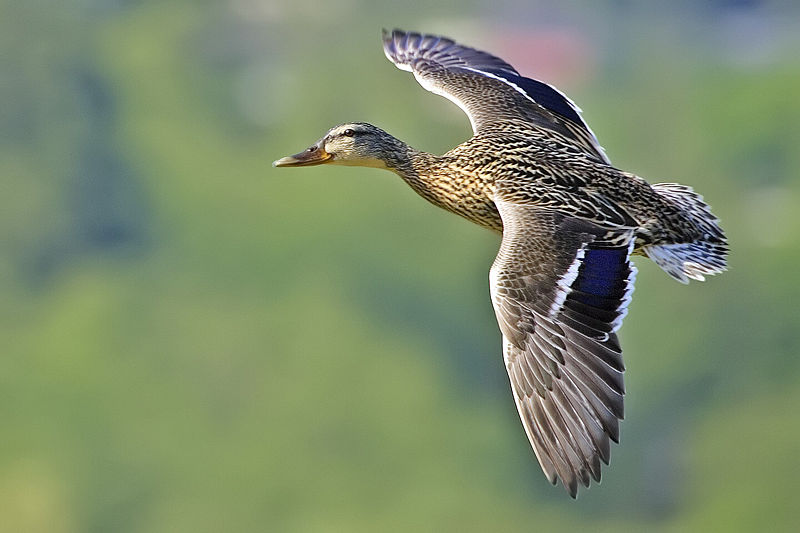 It's been known for a while that birds also use the earth's magnetic field to help them find their way, but we don't know much about the actual way in which this works. Scientists have thought for a while that birds like pigeons might have iron-based molecules somewhere in their bodies that respond to the magnetic field. And now Gerta Fleissner and her colleagues at the University of Frankfurt might have found the elusive particles. The researchers found little particles of iron-based maghemite and magnetite in special parts of nerve cells known as sensory dendrites, which are found in the skin lining the upper beak of homing pigeons. Maghemite and magnetite are crystals containing iron oxide compounds, formed by the reaction of iron with oxygen. The researchers found that these dendrites are arranged in complex three-dimensional patterns. The scientists think that this allows birds to get their bearings in three-dimensional space, using the earth's magnetic field to work out where they are. Effectively, they have their own sat-nav in their beaks. It's also been suggested that this system of nerve cells might also be found in other types of bird, and even some animals that navigate using the earth's magnetic field. And some scientists think that tiny magnetic particles like these could even be used for drug delivery or data storage in the future.
It's been known for a while that birds also use the earth's magnetic field to help them find their way, but we don't know much about the actual way in which this works. Scientists have thought for a while that birds like pigeons might have iron-based molecules somewhere in their bodies that respond to the magnetic field. And now Gerta Fleissner and her colleagues at the University of Frankfurt might have found the elusive particles. The researchers found little particles of iron-based maghemite and magnetite in special parts of nerve cells known as sensory dendrites, which are found in the skin lining the upper beak of homing pigeons. Maghemite and magnetite are crystals containing iron oxide compounds, formed by the reaction of iron with oxygen. The researchers found that these dendrites are arranged in complex three-dimensional patterns. The scientists think that this allows birds to get their bearings in three-dimensional space, using the earth's magnetic field to work out where they are. Effectively, they have their own sat-nav in their beaks. It's also been suggested that this system of nerve cells might also be found in other types of bird, and even some animals that navigate using the earth's magnetic field. And some scientists think that tiny magnetic particles like these could even be used for drug delivery or data storage in the future.
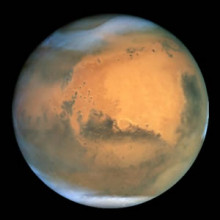
Huge amounts of Ice found on Mars
The European spacecraft Mars Express arrived in Mars orbit in december 2003 to study the planet. It included a giant radar called MARSIS which was designed to look below Mars' surface using long wavelength radio waves. In order to produce the long wavelengths you need a very large aerial, in this case 40m long. This was deployed explosively which the engineers were very worried would destroy the rest of the spacecraft. In the middle of 2005 they finally deployed the aerial which was sucessful.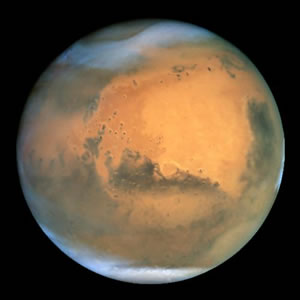 Since 2005 the team has been aquiring and analysing data from below the surface of Mars. On Mars's South pole there is a large ice cap, the land rises around the edge of it, so sceintists assumed that it continued to do so under the ice cap, making it quite small. However new data from the MARSIS radar shows that the land levels off so the ice cap is 2-3 miles thick, and at least 90% water. This is enough water to cover the whole of Mars with 11m of water.
Since 2005 the team has been aquiring and analysing data from below the surface of Mars. On Mars's South pole there is a large ice cap, the land rises around the edge of it, so sceintists assumed that it continued to do so under the ice cap, making it quite small. However new data from the MARSIS radar shows that the land levels off so the ice cap is 2-3 miles thick, and at least 90% water. This is enough water to cover the whole of Mars with 11m of water.
However from features on Mars there must have been ten times more water than this so scientists are still looking for the remainder.
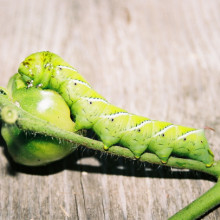
Click before you're sick (if you're a caterpillar)
Scientists have found that, when threatened, a species of silk caterpillar emits a series of audible clicks resembling snapping fingernails. Immediately afterwards theysecrete from their mouths a blob of foul-tasting fluid, which is presumably intended to deter predators such as ants and mice, which avoid foods coated in the chemical. 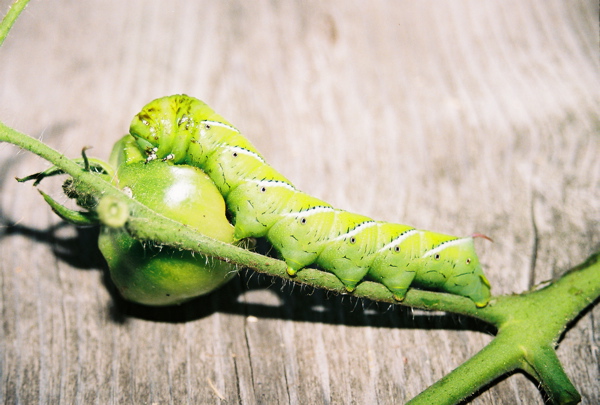 Writing in the journal of Experimental Biology, Sarah Brown, from the University of Ottawa in Canada, found that the caterpillars could be persuaded to perform this defensive manoeuvre in response to unwanted attention from domestic chickens, or even a phony predator in the form of a pair of tweezers. She thinks that the caterpillars resort to an audible warning so that they need not resort to the usual form of deterrent - bright colouration. This means they can remain camouflaged from "casual" predators, but then broadcast their unpalatability if they are detected.
Writing in the journal of Experimental Biology, Sarah Brown, from the University of Ottawa in Canada, found that the caterpillars could be persuaded to perform this defensive manoeuvre in response to unwanted attention from domestic chickens, or even a phony predator in the form of a pair of tweezers. She thinks that the caterpillars resort to an audible warning so that they need not resort to the usual form of deterrent - bright colouration. This means they can remain camouflaged from "casual" predators, but then broadcast their unpalatability if they are detected.

Fat fuels inflammation
If you're carrying a bit of a spare tyre in the tummy department, you probably just think it just affects your clothing size. But increasingly, it's becoming clear that excess fat can have significant health impacts. Now researchers in the US have found that fat in the belly might actually be involved in fuelling inflammation in the body.

When you think of the word inflammation, you probably think of redness or swelling that happens if you get an infected cut. But inflammation throughout the body - and the molecules involved in it - plays an important role in many diseases, including diabetes, heart disease and cancer. This type of inflammation is called "systemic inflammation". Most studies of belly fat have looked at sub-cutaneous fat - the stuff just under the skin - but they haven't found a link between this type of fat and inflammation.
In this study, the researchers looked at visceral fat, which is wrapped around the internal organs in your tummy. To do this, they took blood samples from a vein called the Hepatic Portal vein, which carries blood from the digestive organs into the liver, in obese people. Then they compared this with blood taken from the arm. The scientists then measured the levels of different molecules involved in inflammation. They found high levels of two molecules called IL-6 and C-reactive protein, which are known to be involved in systemic inflammation, and are related to diseases such as high blood pressure, insulin resistance and type 2 diabetes.
Doctors say that if you're an apple-shaped person, with fat stored on your tummy, then you're at greater risk of heart disease and diabetes than pear-shaped people, with fatter hips and thighs. The researchers think that this inflammatory function for fat may be the reason why - and also suggest that keeping down the size of your beer-gut may help more than just the fit of your clothes.
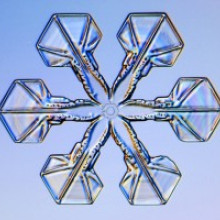
Does hot or cold water freeze first?
There's convection currents going on inside the water...
If you've got something warm, it's less dense so it rises upwards and the cooler stuff sinks. This creates a turning circulation.
If you put that in the freezer, because the water is stirred up by the heat, the water will start moving and it will carry on moving for quite some time and this will keep mixing the water enabling it after its cooled down to keep loosing heat more quickly than cold water because that's more static and doesn't move so much to start with.
Therefore the cold water will be overtaken on the freezing process, possibly by the hot water.
The obvious thing would be that the cold water would freeze first, because its got less energy to lose but I have heard that the hot water would freeze sooner but I've not looked in to it in detail. The convection currents helping the water water freeze first make sense though.
The other thing is if you heat up water and boil it you drive off all the gases dissolved in it, and those gases might be reducing the freezing point.
So, if you did the experiment fairly and used distilled water or something, it would be an accurate way of testing.

Why can you see vapour trails only sometimes?
Its to do with the weather as planes all run on the same fuel, called kerosene which has carbon and hydrogen in it. When you burn it the fuel the hydrogen combines with oxygen in the air to form water, which then condenses to form long, thin clouds that you see. If the plane is flying through a particularly dry piece of air those water droplets will evaporate quite quickly, if its flying through air which is already quite damp then the water can't evaporate and the clouds last for ages.
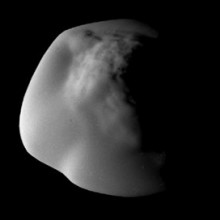
17:11 - Object found in Kuiper Belt suffered impact
Object found in Kuiper Belt suffered impact
with Mike Brown California Institute of Technology
Chris - Mike has found an object at the edge of the solar system in the Kuiper Belt. Tell us a bit about this object Mike?

Mike - This is one of those very interesting things that you stumble upon without having any idea that its there. We found this very interesting object a couple of years ago, its out in space beyond Neptune. Its bigger than Pluto in one dimension but its actually half the size of Pluto in another dimension - its like the shape of an American football that's had some of the air let out if it and has been stepped on, it spins end-over-end every four hours. What we have recently found is that the object was smashed by something else that was maybe half the size of Pluto, maybe four billion years ago and that's what led it to rotate and the interesting thing we finally found is the other chunks that came off it after it got smashed.
Chris - So where have they gone? You'd anticipate that if something was smashed into by something the size of Pluto that the remnants would disappear.
Mike - Two of the little pieces went into orbit around this object, the other six pieces that we found are not in orbit around the object but they are in orbit around the sun. They got ejected from the object itself but they didn't get ejected fast enough so you can still see them in the vicinity of this object out there past Neptune.
Chris - How do you know that those objects are actually from that parent object that first got smashed in to and not just other debris that from nearby?
Mike - The only way that we know that we realise that these are chunks from the original body is that they're all made of exactly the same material and there's nothing else that we've found that's made of exactly the same material. When we found the first object we thought - Wow there's this one big body that rotates really fast and is shaped like a football, then we found a few more smaller ones and thought what's going on? Then it dawned on us that these are in orbit around the sun, if you trace their orbits back you can see that they intersect.
Chris - So that's the outer solar system, but does it give us any clues about the configurations you see closer in nearer to Earth?
Mike - The fascinating implication for the inner solar system is that this collision that happened probably four and a half billion years ago was right at the beginning of the solar system. This collision happened to occur by chance in a region of the solar system that is close to being unstable - that is if you put something in orbit there it won't stay in orbit for a very long time. This means that all of the fragments from this collision have had the chance to become unstable and when they've become unstable they work their way into the inner solar system and they become things that we call comets today. So its very likely, in fact inevitable that some of the comets that we have seen in our lives have been from this actual collision. It must also be that some time in the past chunks of this very large object that broke apart have landed on the Earth.

Glows after a shuttle launch?
The shuttle is just burning hydrogen and oxygen which produces water and then a cloud similar to the way an aeroplane does. If the light caught it correctly as time went by, or it might not have even condensed properly for a while and then the light caught it, hence the glow a while later.
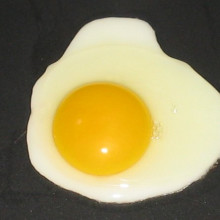
What happens when you fry food?
It's called the Maillard reaction, after the French chemist Louis Camille Maillard.
This is a chemical reaction between carbohydrate groups (that's sugars, largely) and proteins or amino-acids (those are the building blocks of proteins).
It takes place at around 148 degrees Celsius, and when these sugar groups lock on to the amino-acid groups they form these nice, brown caramelised substances which taste great - that's the nice aroma you get from cooking.
As it happens at 148 degrees - that's 48 degrees hotter than water boils at - that's why you get a very different consistency and taste and texture to fried food compared to boiled.
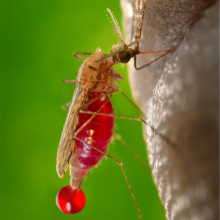
Does beta thalassemia stop you getting malaria?
Yes it is true, you get two copies of every gene; one from mum and one from dad. If you have two duff copies of the beta haemoglobin gene then you'll have quite serious thalassaemia.
If you have only one duff copy then it could actually protect you from blood parasites like malaria. It makes the red cell inhospitable so nothing can grow in there.
Malaria, as a parasite, is optimized to live in a certain type of cell and cellular environment, so if you change that by having different chemicals in there because the gene is slightly different, the result is you will end up with a less hospitable home for the parasite to grow and as a result it doesn't grow so well.
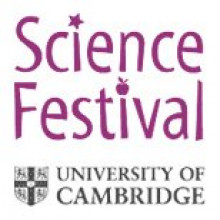
29:41 - The best of the Fest
The best of the Fest
You cannot have failed to notice that it is in fact National Science and Engineering week and the Cambridge Science Festival is now in full swing. Yesterday was the grand opening at that saw at least 10,000 people descend on the town, eager to get hands on and interactive. The really big launch took place yesterday and I went along with some of the other members of the Naked Scientists team to find out a bit more about it. My first port of call was the Pathology department where I had the opportunity to meet the microbes that live in me and on me with Dr Gillian Fraser. 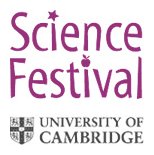 Gillian - What we've done here today is tried to show people the types of bacteria which are associated with our bodies. We've decided to culture some of the bacteria we find on ourselves, for example I've taken a toothpick and taken some of the plaque between my teeth and then I plated on to an agar plate, then I've taken those bacteria and stained them put them under the microscope to see what's there.
Gillian - What we've done here today is tried to show people the types of bacteria which are associated with our bodies. We've decided to culture some of the bacteria we find on ourselves, for example I've taken a toothpick and taken some of the plaque between my teeth and then I plated on to an agar plate, then I've taken those bacteria and stained them put them under the microscope to see what's there.
Chris - So who is the most germ infested pathologist in the department as far as we can tell? Is that you?
Gillian - Yes that honour definitely goes to me, we found some pretty interesting bugs lurking in my mouth; there were some fusobacterium, which are these long, branching bacteria, we also found some streptococci - often those cause things like sore throat but some streptococci are actually quite good for us and protect us from bad bugs.
Chris - You don't look ill. You don't look germ infested, so how can you have all these bugs flourishing on you and in you and yet not be unwell?
Gillian - They're actually very important for us to help prevent bad bacteria from getting a foothold on our epithelial surfaces. They colonise these surface and prevent the bad bacteria from being able to stick there and they can also produce toxins against these bad bacteria which kill them.
Chris - How do these bugs get about?
Gillian - If we go over and have a look through this microscope over here, we've got some lab E. Coli K12, these are motile bacteria. You can see them moving about quite rapidly, now these bugs have these amazing rotary nano machines called flagella, they're long propellers which extend from the bacterial cell surface and they rotate at amazingly high speeds - up to 60 000 rpm.
Chris - I don't mean to insult bacteria, but they're not known for their intelligence. So how do they know which way to swim?
Gillian - Actually bacteria are quite intelligent they have a memory and they can sense their environment by tasting the chemicals in it. They can remember what their environment was like a second ago and make a decision as to whether their life is getting better, or whether its getting worse. They can change their direction so that they travel to a better place, maybe one with more nutrients.
Chris - Gillian Fraser who by her own admission is the most germ-infested member of the pathology department. Now whilst I was getting up close and personal with E. coli, Naked Scientist Meera Senthilingam got wind of a tasty demonstration which was taking place in the Chemistry Department.
Meera - Apparently over at chemistry in Action, they're making ice cream with liquid nitrogen as one of the demonstrations. This method is supposed to give an absolutely delicious result so I'm off to see if I can get my hands on some.
Chemist - so what we're going to do here is make ice cream, we put in our three ice cream ingredients. Firstly the cream, then some milk and finally in my mind the most important ingredient - the sugar. So if you're making ice cream in a factory at home, the way you would do it is to put it in a normal commercial freezer which would be about -25 and you'd stir it as it froze. We don't have a commercial freezer and we also don't have the several hours that it takes to do that, so what we're going to use is liquid nitrogen. The reason ice cream is so tasty is because the sugar dissolves in the water in the milk and that gets frozen into little ice crystals. You can't feel these ice crystals because they're so small and they're surrounded by the fat from the milk and when you put them in your mouth they feel creamy. As the fat gets digested by the enzymes in your mouth it releases the ice crystals and the sugar hits you - Bam! - on your tongue. So as Nitrogen boils off its drawing its energy from the cream which is hotter than it, so its cooling the cream down as it boils off. Does that look like ice cream to you?
Audience - Yes!
Chemist - Ok, lets serve it up.
Meera - So I'm here with Simon and he's going to explain why ice cream tastes better when you make it with liquid Nitrogen.
Simon - When you taste ice cream you're tasting the texture and the grain size of the ice crystals . So if you freeze it really quickly using something at -178 degrees Celsius, you get much, much smaller crystals and so it doesn't taste as grainy.
Meera - What are your names?
Lawrence - Lawrence
Isobel - Isobel
Meera - So what did you think?
Lawrence - I thought that the smoke coming off it was really mystifying, it was very interesting.
Isobel - Its really nice, its nice and creamy.
Meera - Well I thought it was delicious so I'm off in search of the technician to see if I can persuade him to let me take some liquid Nitrogen home.
Chris - Which proves another scientific theory - that you can always trust the girls to track down the food, especially if it involves ice cream or chocolate. Also taking place on Saturday was a presentation by Marc Abrahams the guy who founded the Ig Nobel prizes. Unlike their more auspicious namesakes they're awarded for scientific endeavours that make people laugh then think. Previous winners included a team of doctors who showed that people living near radio stations playing an above average amount of country music are much more likely to kill themselves on average and another study which sought to confirm the myth that belly button fluff is always blue. Ben Valsler went along to see what visitors thought of the Ig Noble concept.
Marc - Most prizes are for the very best of something or the very worst of something, best or worst doesn't matter for the Ig Nobel prizes. Important or worthless, that too doesn't matter. All that matters is that you've done something that first makes people laugh and then makes them think
Ben - Why is it that you've decided to come to the Ig Nobel prize show?
Man 1 - We've actually seen it before a couple of years ago and were really entertained. So we came to see it again and see if there's anything new.
Man 2 - Because I believe it can be quite amusing.
Man 3 - The idea of joke science is appealing to me. I'm looking forward to this.
Marc - The Ig Nobel prizes are given every year - we started doing this in 1991. we give ten of these a year, they're all about things that first make people laugh, then make people think. The Ig Nobel literature prize is awarded to Daniel Oppenheimer, for his report called "Consequences of erudite vernacular utilised irrespective of necessity - problems with using long words needlessly." The Ig Nobel medicine prize was awarded to Dr Francis Fesmire of Tenesse for his medical case report called "Termination of intractable hiccups with digital rectal massage." Is there anyone here who needs this concept clarified? Is there anyone here who has hiccups at the moment?
Ben - Do you think we're a bit too serious about science?
Man 4 - Yeah I think we are quite a bit of the time. I think this is a good example of how it should be.
Woman 1 - Oh yes.
Ben - So its nice to see a light-hearted approach in something like this?
Woman 2 - Oh yes definitely! Having done a PhD people take it much to seriously.
Chris - I should think that just the thought of a digital rectal exam is enough to cure most cases of hiccups. That was Ben Valsler finding out about the Ig Nobel prizes. Now someone who is clearly enjoying the festival very much is the University's Vice-Chancellor Professor Alison Richard.
Alison - I think that the Cambridge Science Festival this year is brilliant. But then of course its brilliant every year and how do I know that? You just walk around and look at the faces, the kids are totally intent, its also the volunteers who are completely intent talking to the kids; there's just an engagement - complicated things are made simple and explicable, even people like me imagine for a brief moment that you actually understand some of this stuff. I have a question for you because I've been failing to get the answers right on many questions this morning, do you know how many bones there are in the human body?
Chris - Adult or baby?
Alison - Adult.
Chris - 206.
Alison - Oh, oh, oh Naked Scientist you know it all! One of the other answers was 348, now I'm a biological anthropologist and I got the answer wrong so its never too late to learn and I think that's the message for the grown ups here. You can always learn more.
Chris - I can't tell you how relieve I am that I could actually answer that question because my cred was surfing on that.
Alison - Brilliant, that's brilliant Naked Scientist, I'm impressed.
Chris - Now what's this very interesting, colourful thing?
Alison - This is the structure of DNA its the double helix, its also a kind of molecular origami. I folded paper to make this. It hard to describe if you can't see it but I'm very proud of it and its going to go home and sit on my mantle piece. Its fun to make it and to me this is the embodiment of this festival - that its taking very complex ideas turning them into something physical that you can actually do and take away and think about and that's great.
Chris - You must have quite a collection of these because last year you were walking about with a giant pink balloon that you were telling me was some salmonella.
Alison - It was not a giant pink balloon at all - it was a bacterium, I've forgotten what the species was but it was definitely a bacterium. The year before that I built a robot, maybe you don't remember but I still have that - my robot car, its great.
Chris - Where are you heading off to next?
Alison - Now I'm off to the University centre where there is a crane construction challenge. I've no idea what that means but I'll go and find out.
Chris - Cambridge University's Vice Chancellor Alison Richard enjoying the Cambridge Science Festival yesterday. Its the country's largest free science festival. All the events and exhibitions are continuing all this week and if you want to go along there's plenty to go and see. There's another big "Science on Saturday" in a week's time and all the details are on their website, that's cambridgescience.org

40:40 - Symbiosis meets Climate Change - Science Update
Symbiosis meets Climate Change - Science Update
This week for the Naked Scientists, symbiosis meets climate change. In case you don't remember from school, symbiosis is when totally different types of organisms live together in a mutually beneficial relationship-- sort of like marriage. I'm going to talk about a trio of co-dependent creatures that like it really hot. But first, Chelsea tells us how the warming world is causing corals and their algae partners to break up.
Even if you're worried about global warming, it probably seems like a fairly distant threat. But to coral reefs it's a clear and present danger. Evolutionary ecologist Drew Harvell of Cornell says warm temperatures seem to weaken corals' immune systems while at the same time causing diseases to flourish: a one-two punch. What's more, corals have a symbiotic relationship with a type of algae that provide them with oxygen and nutrients.
DREW HARVELL (Cornell University):
And the algae are actually very sensitive to changes in temperature and so even a one or two degree increase in temperature can cause the symbiosis to fall apart and the coral can die.
In fact, scientists have documented several cases of heat-related coral death around the world. Harvell and others hope to save those that remain by finding ways to boost their immunity, kill their diseases, and protect them from people.
Thanks, Chelsea. There's a kind of grass called "panic grass" in Yellowstone National Park here in the U.S. that thrives in hot geothermal soils, which can reach 50 degrees Celsius. It was recently discovered that a kind of fungus on the plant's roots makes this possible: neither the fungus nor the grass can withstand the high temperatures alone.
But now, researchers have found that the fungus confers this heat-resisting power only when it's infected with a virus. Marilyn Roossinck of the Samuel Roberts Noble Foundation in Oklahoma says they were able to reveal the three-way dependency by curing some of the plants of the virus.
MARILYN ROOSSINCK (Samuel Roberts Noble Foundation):
When the plants were colonized with the fungus infected with the virus, then they were heat tolerant. And when they were colonized with the fungus without the virus, or with no fungus, they died under the heat stress. Roossinck says understanding survival mechanisms like these isn't just academically interesting.
With the global climate changes that we are all facing now, we're going to see a lot more extreme environments on the planet, and that would include higher temperatures, probably also more periods of drought. So we need to understand how plants normally tolerate natural extreme environments. That may better equip us to grow crops when environments that seem extreme today become more normal.
Thanks, Bob. Next time we'll talk about how some scientists are using sound to make the lovely sights of public aquaria accessible to the visually impaired. Until then, I'm Chelsea Wald... -
...and I'm Bob Hirshon, for AAAS, The Science Society. Back to you, Naked Scientists...
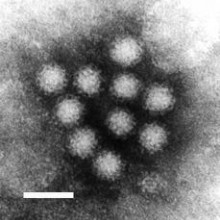
43:36 - Virus particles in crystal sarchophagus
Virus particles in crystal sarchophagus
with Peter Metcalf University of Auckland
Chris - Peter Metcalf from the University of Auckland, New Zealand has uncovered a very interesting crystal structure of an insect virus. It makes these things in cells and they behave a bit like a viral sarcophagus, the virus gets locked away inside this crystal structure and it protects the virus when it gets out of the insect and into the soil. These things wait for hapless insects to come by and then infect them. He's published this in the journal Nature recently so its obviously an important discovery, its been a mystery for sometime though hasn't it peter, how these things worked?
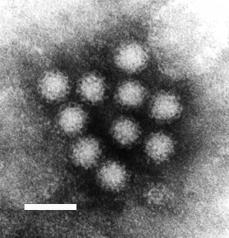
Peter - Yes these crystals have been known since the end of the 19th Century and they were the first and only viruses that you can see with a microscope. People have always been puzzled as to what these crystals are and it turns out that these crystals actually contain virus particles. These are much too small to be seen with a microscope.
Chris - How many are in each crystal Peter?
Peter - Each crystal contains thousands of virus particles, so the actual infectious object that the insect eats when it gets infected is a little crystal containing virus particles.
Chris - Why does it need to resort to that, because there are lots of viruses around that don't use this technique, so why do these insect viruses have to make these clever sarcophagi to lock themselves into?
Peter - Nobody really knows that but what we thing is the crystals stabilise the virus, most viruses don't last very long in the environment, but these crystals containing the viruses last for years and years. In fact when you eat a cabbage from the supermarket you're likely to be eating these viruses because the crystals last so long, they're really impossible to get rid of.
Chris - How did you break the structure of them? How did you work out what they were made of these crystals?
Peter - Whilst the crystals are big enough to be seen by a light microscope they're very small compared to the crystals that protein crystalographers generally use. So we're X-ray crystalographers and we use a very special new micro X-ray beam at the Swiss light source which is a synchrotron near Zurich. We use this beam to shoot these crystals to figure out the atomic structure.
Chris - So the X-ray goes into the crystal it gets bounced about all over the place and the pattern of beams of light that come out tell you something about how the atoms must be arranged inside the crystal.
Peter - That's right, exactly.
Chris - So now you've sussed this out does it tell you anything useful in terms of how we might be able to exploit these particular crystals for medicine or technology?
Peter - Yes, it certainly does because what we did was to figure out the atomic structure of the crystal so we know how they're made in great detail and that means that we can modify them and the interesting thing is we found inside the crystal nucleotides (the sub-units of DNA) and that means that we can put other things in these crystals and we also know how to put things into crystals instead of the virus. So the crystals can be used as micro containers, very small objects containing other things and stabilising them.
Chris - So given that you can stabilise a virus naturally, that's how the insect virus works, a big problem in the third world with vaccines is keeping things in a fridge because third world countries don't have power for long enough to power fridges. Could you therefore use this as a novel kind of vaccine technology where you could put very fragile viruses inside these things? They would be stabilised, they could then be transported all over the place and given to people when they needed them and they would protect them.
Peter - Yes, that's certainly one of our thoughts. There's a whole variety of applications , the lack of stability of proteins in general is a big problem in biotechnology and so a nice method like this for stabilising them is generally important.
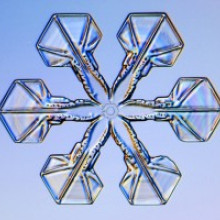









Comments
Add a comment